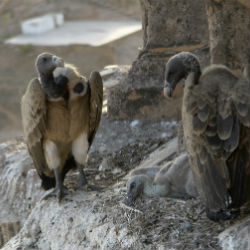
A somewhat bizarre statistic heard on the radio this morning. The discussion was on the conflict between economists, who want growth, and environmentalists, who want sustainability; not quite as extreme as bunny-huggers versus cut-down-every-rainforest-in-sight-because-we-can-sell-the-logs-for-money, but that’s the gist of it. The allegation was that economists leave the financial returns that nature provides out of their calculations; so that money spent, say, preserving Indian vultures is essentially money wasted. Vultures should not stand in the way of progress. The statistics was from Tony Juniper.
So how on earth can nature – Indian vultures in this case – provide a financial return? Here’s the argument:
 In the 1980s, India had around 40 million vultures, spread around nine different species. Then a drug called diclofenac was introduced and became widely used for treating cattle. Vultures eat dead cattle; the diclenofac remaining in cattle carcasses kills vulture. If even 1% of cattle carcasses contain diclofenac then the population of vultures declines severely; in fact around 10% of carcasses contain it. The result has been that the vulture population has plummeted from a whacking 40 million to a mere 60,000 – very roughly one-thousandth of it is previous size. Some of the species are so imperilled that captive breeding programmes are being used as a last resort to save them from extinction.
In the 1980s, India had around 40 million vultures, spread around nine different species. Then a drug called diclofenac was introduced and became widely used for treating cattle. Vultures eat dead cattle; the diclenofac remaining in cattle carcasses kills vulture. If even 1% of cattle carcasses contain diclofenac then the population of vultures declines severely; in fact around 10% of carcasses contain it. The result has been that the vulture population has plummeted from a whacking 40 million to a mere 60,000 – very roughly one-thousandth of it is previous size. Some of the species are so imperilled that captive breeding programmes are being used as a last resort to save them from extinction.
So where’s the financial cost come in? How are vultures suppose to pay for their continued existence? Follow the consequences through. Vultures don’t eat cattle corpses any more. So what does eat them? Answer: India’s feral wild dogs, the population of which has rocketed. So what? So wild dogs bite people and give them rabies. India already had has the highest rate of human rabies (deaths?) in the world. It has been estimated that 50,000 extra rabies deaths have been caused by the extra number of feral dogs. (That’s a 2008 figure – it must be higher by now). That is 50,000 deaths since the start of the decline in vultures. Deaths of course have much more than financial consequences, but they do have financial consequences, not least for the families of the dead; and the cost to the Indian economy of those 50,000 deaths has been calculated, if I caught the figure right, at £34 billion – call it $50 billion. That is the statistics that caught my attention. It came from eco-warrior Tony Juniper, who was on the radio to publicise a new book – What has Nature ever done for us? How money really does grow on trees.
Of course, no sums are really that simple. The diclofenac certainly brought economic benefits to India’s farmers – very many of whom are very poor. Not using it costs them money. But $50 billion-dollars-worth of money? At that price, wouldn’t bringing back the vultures seem an economic bargain, money well invested, even if it did cost a bob or two?
There are of course sensible courses of action that keep both sides happy. India has found one: Diclofenac has been banned for use in cattle, in favour of another drug called Meloxicam which protects cattle but which has no effect on vultures. The Bombay Natural History Society, the pressure group for vultures, reported last month that, for the first time, the decline in vultures may have stabilised.
Nature provides other financial services as well as rabies control. (Though sadly not registered under the Financial Services Act, which gets quoted at we Brits in every advertisement about anything vaguely connected to banking.) Flood plains prevent expensive down-stream flooding (so perhaps we should not build on them?); wetlands purify water (have you any idea how much man-made purification plants cost?) Climate change is costing us real money, now that nature has stopped providing the service for free. A pioneering academic paper by a man by the name of Costanza and others in 1997 attempted to put a price on these and other services that nature provides worldwide. It came up with the figure of between $16 and $54 trillion annually – though this figure has been described as ‘a serious underestimate of infinity.’
Moral: If you are doing sums about money, and claiming an economic benefit for a certain course of action, don’t leave out the most important bits.



